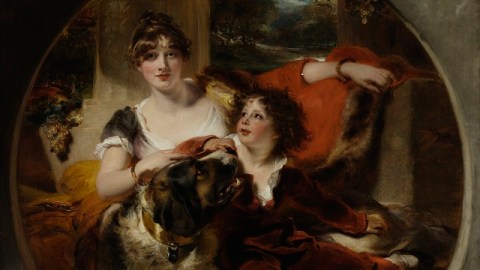Women and Children First: Thomas Lawrence’s Portraits

“Nobody has ever painted eyes, women’s eyes particularly, so well as Lawrence,” Romantic painter Eugene Delacroix wrote after visiting British painter Thomas Lawrence in 1825 and finding himself bowled over by his portraits. “And those parted lips which are completely charming. He is inimitable.” In the exhibition Thomas Lawrence: Regency Power and Brilliance, which runs at the Yale Center for British Art through June 5, 2011, Lawrence once again bowls over viewers with the ravishing beauty of his painted ladies, the subtly erotic attraction of his youthful subjects, and the powerful, peacock-like men hailing from the halls of power. Men ruled the day when Lawrence painted, yet today it seems as if it is the women and children who come first—not in the classic chivalric call of high seas lifesaving, but rather in a resurfacing and reevaluation of Lawrence’s art that may mark the salvation of the heyday of British portraiture.
The catalog, which is the first major monograph on Lawrence in three decades, separates the portraits roughly into the three main categories of men, women, and children. Peter Funnell’s essay on Lawrence’s portraits of men focuses on the nature of masculinity during the Regency period in England and how Lawrence not only captured that on canvas, but also attempted to embody that persona himself. “Lawrence’s career spanned a period that saw considerable changes in what was accepted as correct and admirable male behavior,” Funnell explains, borrowing terms from another scholar to boil down the difference to a move away from “gentlemanly politeness” towards “manly simplicity.” Refined gentlemen gave way to straight-shooting manly men who lived, loved, and led in an almost Byron-esque manner, and Lawrence was there to paint what that new man looked like. Lawrence’s personal model for the Romantic “man of feeling” was fellow artist Henry Fuseli. Lawrence later projected (or detected) the same feeling in the wealthy and powerful figures posing for him, eventually evolving into “a type of flamboyant, aristocratic masculinity” as comfortable with the dramatic theater as with the theater of war.
A. Cassandra Albinson, curator of the exhibition at the Yale Center for British Art, analyzes the allure of Lawrence’s portraits of women. She centers her analysis on the myth of Cupid and Psyche, which Lawrence himself alluded to and even imagined himself in the role of Cupid as a “shadow identity.” Relying on the critical tropes of “voyeurism” and “the gaze” embedded in Lawrence’s myth of choice, Albinson sees Lawrence’s complex relationship with his women subjects as simultaneously a liability and a strength. “Lawrence’s creation of a zone of intimacy between artist and sitter caused anxiety among critics and potential clients, and at times damaged his reputation,” Albinson argues. “But it also piqued interest in his portraits of women and gave them a sense of spontaneity, liveliness and sensuality that his competitors could not match.” Lawrence’s private school for scandal taught him how to penetrate to the vivacious core of the strong women often caught in the orbit of strong men who still controlled the levers of power.
A popular joke of the time argued that if you wanted a portrait of your wife, you went to Thomas Phillips, a great and “safe” painter. If you wanted a portrait of your mistress, however, you went to Lawrence. John Julius Angerstein, Lawrence’s greatest patron, not only sent his wife and his mistress to be immortalized by Lawrence, but he hit the trifecta by having his mistress pose with their illegitimate son. Lawrence’s Frances Hawkins and her Son, John James Hamilton serves as a perfect example of his gift for painting sexy women and subtly sexy children. Albinson reads Frances’ expression “as that of a satisfied woman who has gained access to her own powers of vision.” Her son, however, sees with a different kind of vision, that of Rousseau’s romantic child trailing clouds of glory. “Lawrence’s child portraits suggest that he evolved a repertoire of pictorial devices to exploit the spiritual and physical properties attributed to children at the time,” Marcia Pointon writes in her essay, “to make them appear unflinchingly contemporary and arrestingly stylish, while avoiding pastiche and conventionality.” The little boy looks up with angelic grace at his mother, but he extends her sensuality with his seductive brand of power—a little universe of potential, born of a passion outside the rules of society.
Years before I read Delacroix’s comments about Lawrence’s ladies’ eyes, I had a similar experience the first time I came face to face with a female portrait by Lawrence. The eyes seemed alive in a way that I’d never witnessed before in painting. I came to love Lawrence through his women and children first and through his men later. Like Anthony Van Dyck, the Flemish father of British portraiture, Lawrence made his subjects more beautiful than could possibly have been in real life. He painted ideal figures of power, feeling, sensuality, and innocence and tagged onto them the real-life names of those who served as the catalysts for those meditations on the abstract. Thomas Lawrence: Regency Power and Brilliance brings to an American audience an artist they’ve never truly seen before in all his glory and demonstrates that this “period portraitist” transcends his age.
[Image: Thomas Lawrence. Frances Hawkins and her Son, John James Hamilton, 1805–6. Oil on canvas. Abercorn Heirlooms Settlement Trustees.]
[Many thanks to the Yale Center for British Art and Yale University Press for the image above from and a review copy of the catalog to the exhibition Thomas Lawrence: Regency Power and Brilliance, which runs through June 5, 2011.]





